Filing Cabinet Declutter: How to Organize All Your Important Paperwork
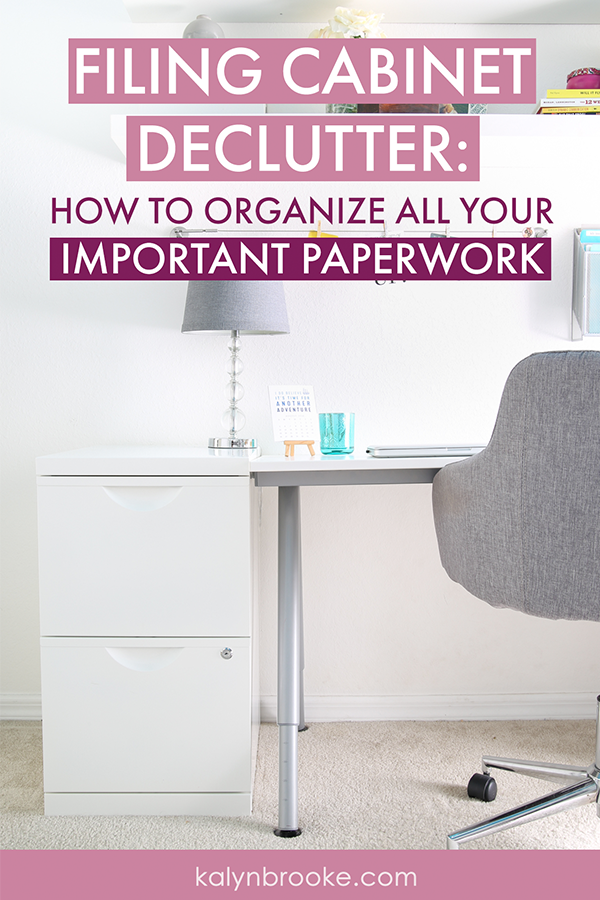
After struggling for the 257th time to close my filing cabinet drawers, I finally broke down.
It was time—time to not only declutter all the paperwork stuffed inside, sticking haphazardly out of file folders at odd angles like morning bedhead. But also because warped drawers made my filing cabinet a barely functional piece of furniture, and nowhere near an efficient organization system!
Not everyone would lament the purchase of a new filing cabinet, but I loved my old one.
I had spent so much time researching how to turn this previously ugly black piece of furniture to grey. It perfectly complimented the color scheme of my new home office—and spray painting all the nooks and crannies—and I hated to see it go!
But I needed a new filing cabinet—and a good declutter session too!

This was as good an excuse as any to purge old Kmart pay stubs (from 11+ years ago) and ripped-out magazine pages I was saving for blog post ideas (but never looked at). I was looking forward to having a filing system that I didn’t have to yank on to open and shove to close.
Here’s the two-step process I used to wrangle my overflowing filing cabinet into submission.
With just these two steps, you can easily overhaul your own filing cabinet or file box. Or even that stack of paper stuffed in the drawer that you have no idea what to do with yet!
Related: 10 Hot Spots Hiding in Your Home … that You Can Declutter in 10 Minutes or Less!
Step 1: Decide what to keep and what to toss
I’ll admit it: The absolute hardest and most time-consuming part was figuring out what to do with all that paper clutter. There was so much to sort through!
To make this part easier, schedule a 2-3 hour block of your evening or Saturday, play some music, and reward yourself afterward with something fun (and maybe these cookies!). Don’t be afraid to ask for help, too! Know a friend who’s also been bemoaning the state of her filing system? Make a party of it.
I enlisted Joseph; I sorted and he shredded, thus cutting our time investment in half!
I found this to be surprisingly true and maybe you will, too: I needed to hang on to WAY less paper than I thought. So much of what I had previously filed could either be electronically kept in Evernote or shredded.
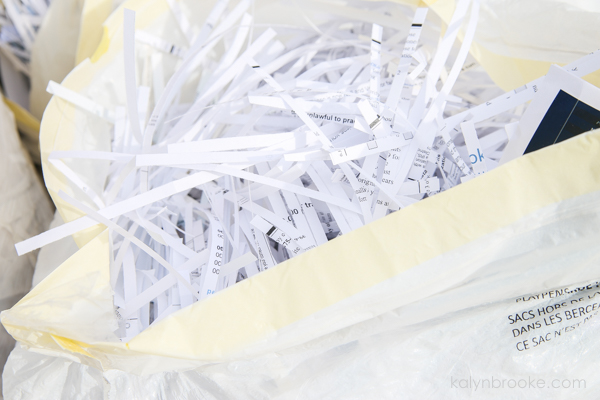
For instance:
- Most credit card and bank statements are already stored electronically. (For example, Chase keeps them up to 7 years.) So why was I hanging onto all those print-outs? TOSS!
- Pay stubs from over a decade ago were already documented on my year-end W-2’s & taxes. TOSS!
- Old medical bills and expired insurance policies had no use. I’ll never need to reference them again. TOSS!
So I shredded…with abandon.
I got rid of SO much paperwork that our shredder overheated. Twice.
By the end, I filled up only one drawer of my new two-drawer filing cabinet! Psst…this one is from IKEA, but here’s a similar one on Amazon.
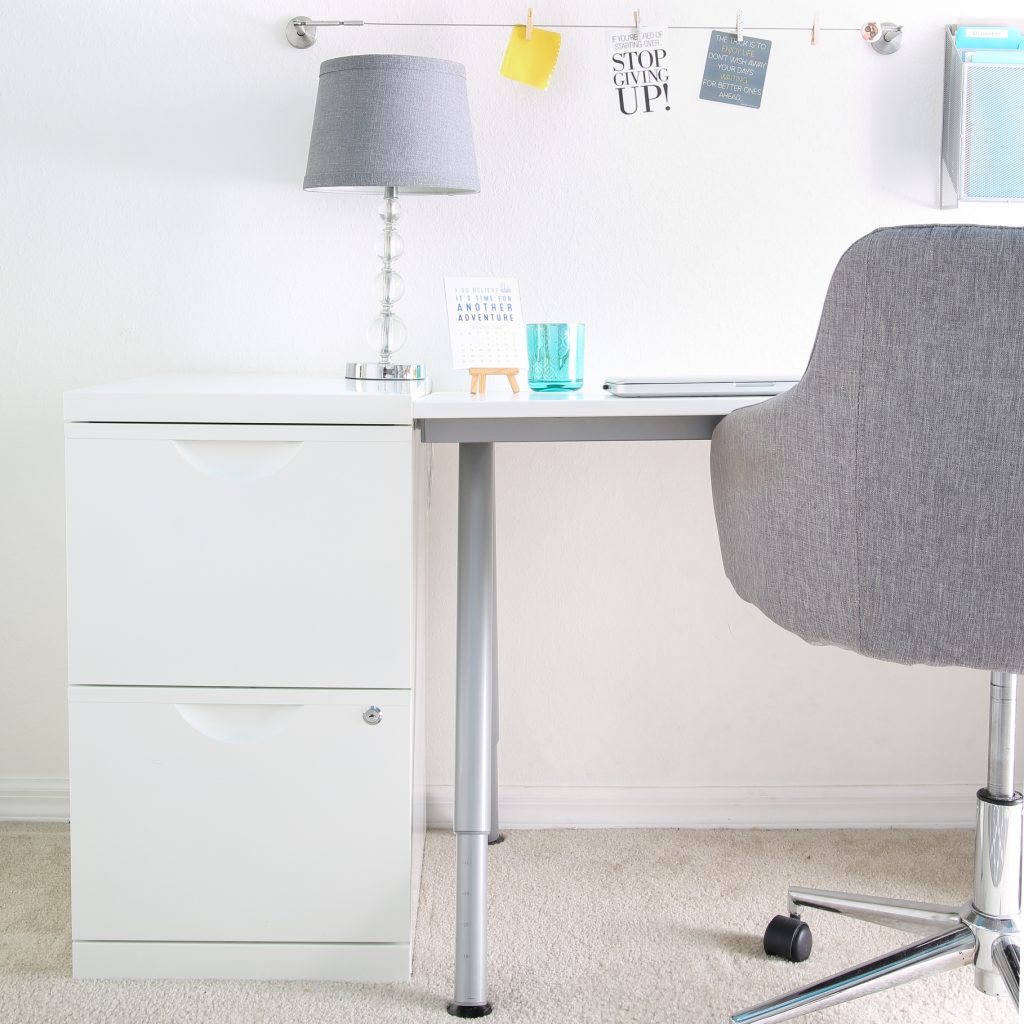
Wish you had a cheat sheet so you could be sure how long you should keep certain financial documents?
I did too…so I created one. Download my easy-to-use printable below to help guide you through the process of purging your paper clutter!
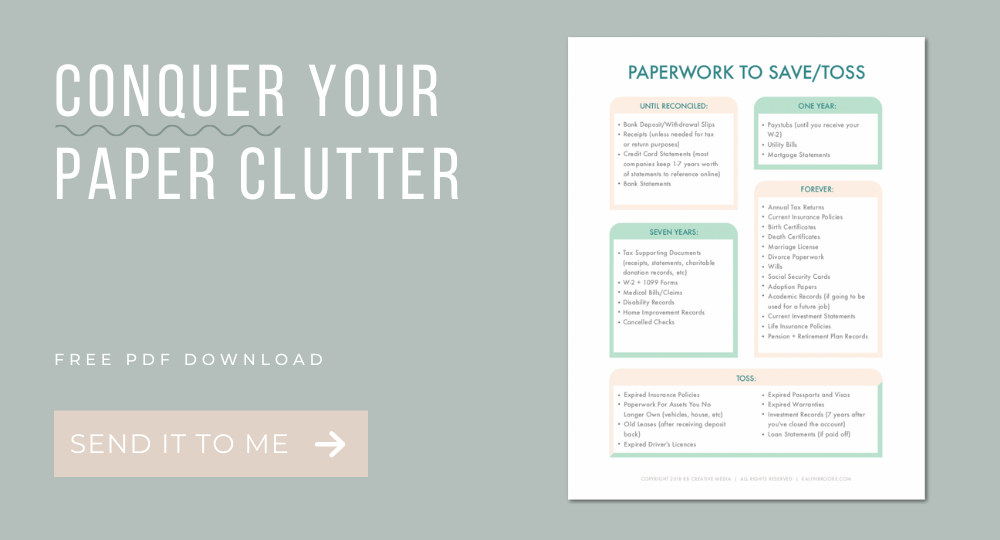
Step 2. Organize the Paperwork That’s Left
The second step is just as important: what should I keep where?
Obviously, my remaining documents had more than enough room inside my new filing cabinet. But I also wanted to use Evernote (my favorite digital tool!) to help me eliminate as many physical copies as possible, while still offering a searchable way to reference them if needed.
For me, organizing paperwork digitally meant including things like vet receipts.
I like seeing not just how much we spend at the vet each year, but I also want to know what procedures were done when or what medications have been prescribed in the past. But I’ll never need that physical paper again. So I scanned it right into the Evernote app!
Related: How to Easily Organize Your Receipts for the Entire Year
How to Easily Organize Paperwork in Evernote:
One of Evernote’s best features is the scanning ability on the smartphone app. This made filing things away electronically a breeze! I could just open up the app, snap a photo, tag and file my note and archive it inside the proper “notebook.”

Here’s an example of how I filed paperwork electronically, using the vet receipt example I mentioned earlier:
- After uploading the receipt, I added it to my “Personal Library” notebook.
- Then I added three tags: “receipt”, “vet”, and “cinder.” This references the TYPE of document it was, WHAT it was for, and WHO it related to.
- So now when I run an Evernote search for Cinder’s vet receipts, all of them will show up in the left hand column!

Related: Evernote 101: How to Create a Completely Organized Digital Filing Cabinet
How to Organize Physical Paperwork:
I decided to keep in my new filing cabinet paperwork that might eventually get tossed but that I know I’ll need again. Even if I know I’ll only need that paperwork to hang around for a year…or seven (if it’s tax-related!), it’s safely filed away.
Forever records like our birth certificates and marriage license went back into the filing cabinet, too.
Side note: I found gorgeous gold and silver hanging folders on clearance at Target. They were less than a box of the plain brown ones, so I just had to snatch them up! The design I used isn’t available anymore, but here’s a different set in my favorite color.
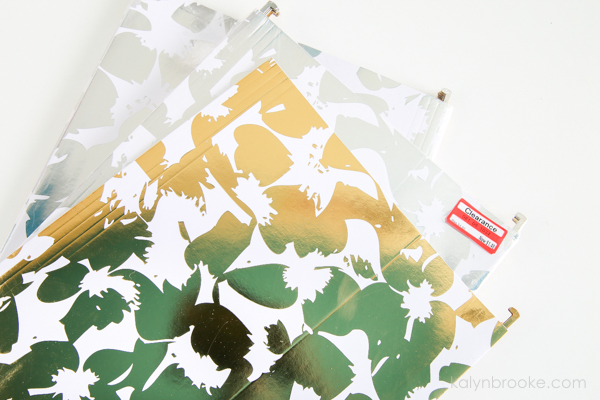
Each paperwork category had its own folder (utility bills, taxes, insurance, etc) that received a colored dot from this Powersheets sticker book, and a title using my handy label maker.
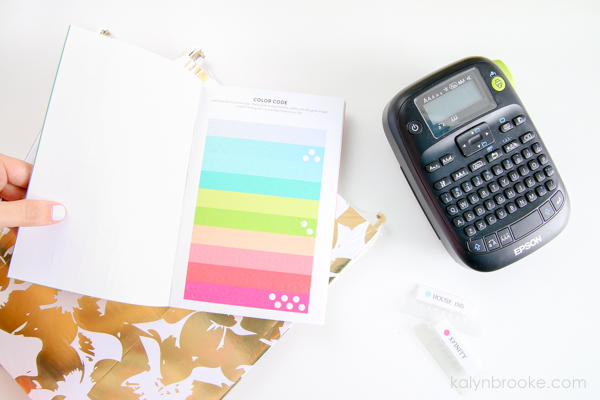
Why the labels and stickers?
Because one of the problem areas I had before was finding paperwork I actually did need to reference. Now, it’s so much easier to just do a quick Evernote search (for my digital scans) or find the right color-coded dot. And there’s not as much paperwork to sort through anymore too!
There’s no one best way to organize paper files, (Kathryn from Do it on a Dime does it by month!), but here’s how I color-coded. You can play with this according to how your brain works.
- Pink: Bills and credit card related documents
- Blue: All insurances (health, flood, house)
- Green: Assets (banks, house, car)
- Periwinkle: All tax years
- Orange: Miscellaneous files
And this was the (pretty) end result!

Ahhh…so much better than before.
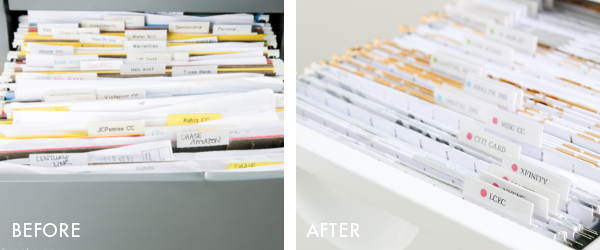
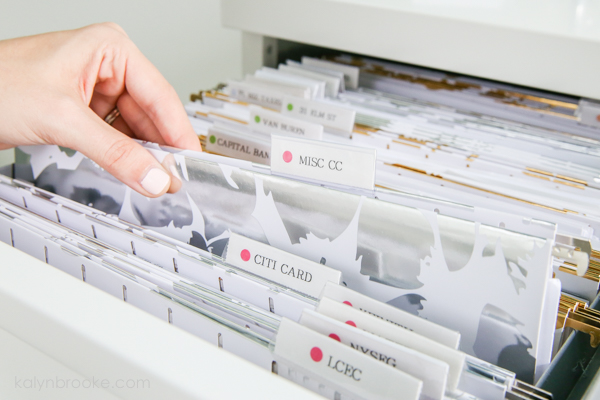
I use a similar filing system for my email management as well!
What I quickly realized
I won’t lie—this was a very time-consuming project (it took almost an entire weekend!). Mostly because I had to make decisions about all of my paper clutter, what to keep and what to toss. AND how to organize paperwork in the most efficient way!
But it feels so good to be done with it.
Previously, even though all that paper was “neatly” filed away in a filing cabinet, it was still clutter I shouldn’t have hung on to for so long. Organizing clutter doesn’t make it any better…it’s still clutter! But now each piece of paper I have has a greater purpose attached to it, and it causes me to really assess what I need to save going forward.
Not to mention I’ll have an easier time finding papers I need because I have way less paper on hand.
The six garbage bags stuffed full of shredded paper can attest to that!
Let’s chat:
Does your filing cabinet or file box need a complete overhaul? What paperwork have you been hanging onto that you don’t actually need?
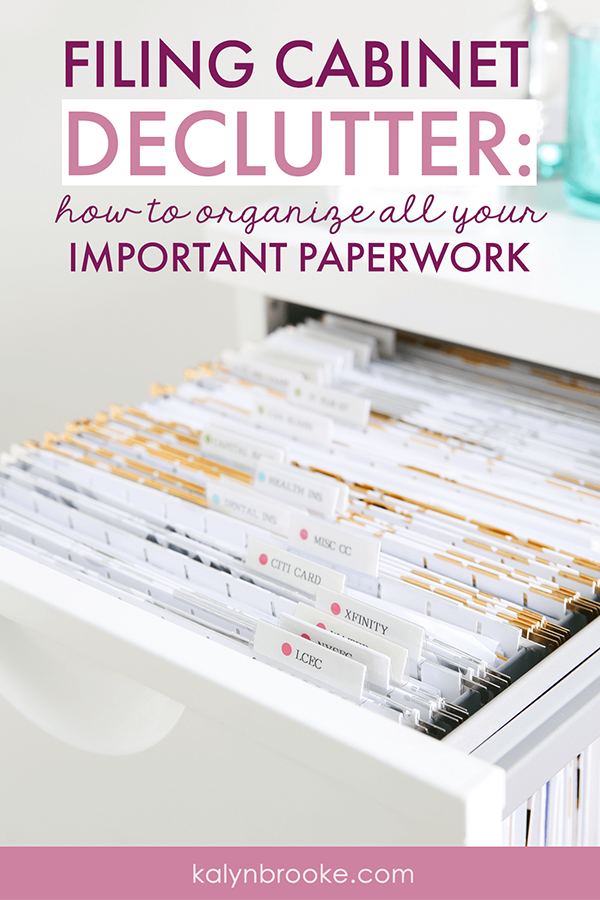
Disclosure: Some of the links in the post above are affiliate links. This means if you click on the link and purchase the item, I will receive an affiliate commission. Regardless, I only recommend products or services I use personally and believe will add value to my readers. Read my full disclosure policy here.

I was wondering where did you purchase your hanging file folders? It looks really pretty!
Hi Diana, they were in the clearance section of Target from a few years ago!
Thank you for sharing. I have to master my piles. I hate the mail. And wish I really could be this organized. The purge has started, but didn’t feel complete. I like the idea of being able to find stuff with your dot system and electronic system. Both will be very helpful.
Connie
I understand the struggle!! Don’t give up, though. Even just working on it for 10 minutes a day will yield amazing results over time!
I couldn’t download your Cheat Sheet. I would love to have it. Paper is a nightmare and this will make it easier. Also where did you get your color labels?
Hi Diane! Please send us an email at [email protected] and we’ll get that sorted out for you!
I have to disagree with some of your suggestions. After 30 years as a computer programmer and database administrator, I’ve seen too much electronic information disappear or become inaccessible not to keep critical data in paper format. And that was when I had a team of Unix technicians behind me and an arsenal of big bucks software supposedly keeping things safe. Inexpensive consumer products like Evernote are only moderately reliable. Putting data somewhere up in “the cloud” puts us at risk for identity theft.
Keeping paper files purged (and shredded) is an excellent idea. Relying on the sketchy electronic products available to us average folks, not so much.
Thanks so much for your input and your expertise. I see it as a risk assessment either way. As you well know, electronic data is far from foolproof. It’s why I keep two backups of the information on my computer because if it were to ever “die” I want the best chance possible of recovering my information. But physical data isn’t free from risk either. Fire, vandals, floods, etc are all ways that physical data is at risk. It’s up to each of us to choose what risks we can mitigate, and what risks we are willing to live with. 🙂
I’m very interested in moving ALL (or at least as much as possible) of my Filing to Evernote! But I’m finding many, many different approaches out there. How can I be sure I have the best method for me? For example, take a look at https://www.makeuseof.com/tag/organize-evernote-tags/ where he describes the reason not to use a bunch of folders, but rather use tags (and he has a very specific way of organizing his tags with 1 2 3). I’d really like to hear a comment, suggestions, your view on this.
Thanks
Hi Mike,
As you’ve already found, there are two organization methods to Evernote: Notebooks vs. Tags. And people are very opinionated about which one to use—LOL! Since writing this post, I spent a lot of time switching my own method over to a similar tagging hierarchy. I have 4 main tags (1 :: Type, 2 :: Topic, 3 :: Name, 4 :: Biz Topic). While I like that it reduces the amount of tags I see at one time because they are collapsible, I never took the time to initiate such a detailed search.
I’ll give you an example: Right now, I have a vet bill tagged with three tags 1 :: Receipts, 2 :: Vet, 3 :: Cinder (name of our rabbit). I like the IDEA that I can pull up all vet bills for Cinder with that one search, but I never ended up using that search in real life. I would always just type “Cinder” into the search bar and scroll through the notes that popped up.
All that to say, I felt like revamping my whole organization system was an unnecessary step.
I agree that you should keep notebooks fairly broad, but then just use tags for the TYPE of file it is. So you could have one big Medical Folder, but a “dental” tag, “hospital” tag, “immunization” tag and so on.
I hope that helps you figure out the right system for you!
After a house fire and all my “important” papers being returned to me from the restoration people, I realized I really should take a look. 10 years of stuff, tax returns, etc. I was able to sort down from 1 4-drawer, lateral to one about the size of yours. That so many options are online, vs what existed the 10 years ago when I started saving is a factor, but during the 10 years of tech development, I still didn’t look back. Hence the Paper Clutter Monster!. It was very freeing, while I wondered why I saved so much to start with.
Then I read somewhere that once something is put into a file drawer, the average time it sits before someone looks at it again is 7-10 years. Sounds about right.
I loved your file folders!
Mark and I are SO going to make an event of our filing cabinet declutter like you did…and an ice cream reward sounds fantabulous! Thanks for doing all the mind-numbing work for us so we can follow in your VERY organized footsteps. I love it all…from the dots to using Evernote to the printable of what to save and toss to that inspiring before and after photo! Brava! Yes, this was WELL worth the investment of time and effort.
Ice cream motivation for the win! 🙂 Oh…and it’s also nice to have that second filing cabinet GONE!